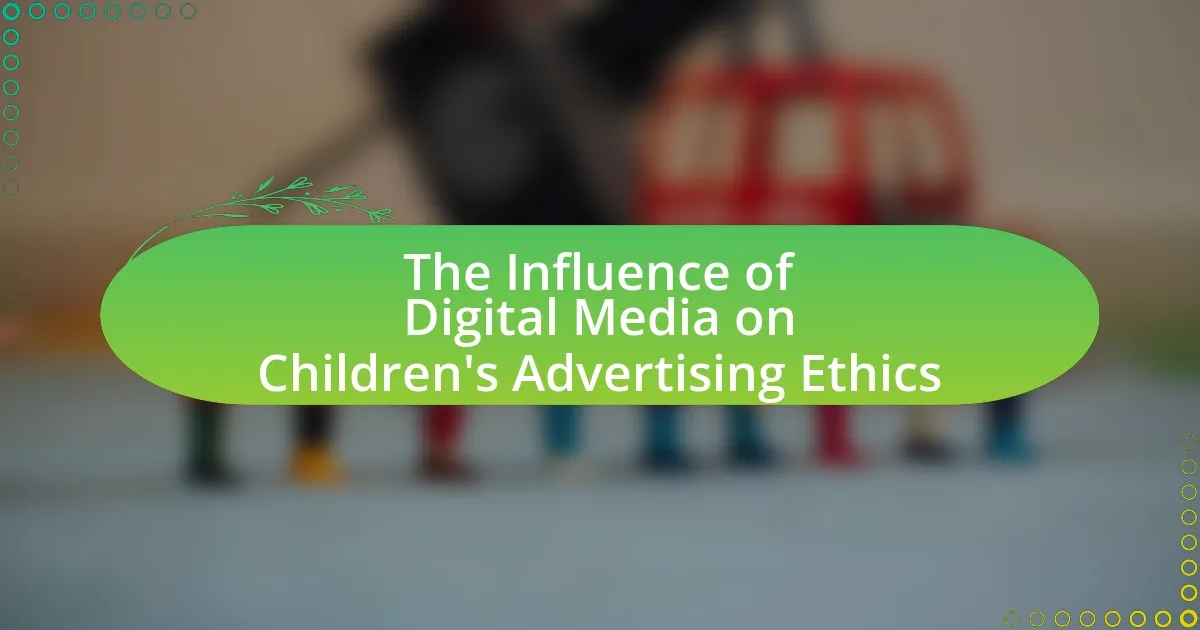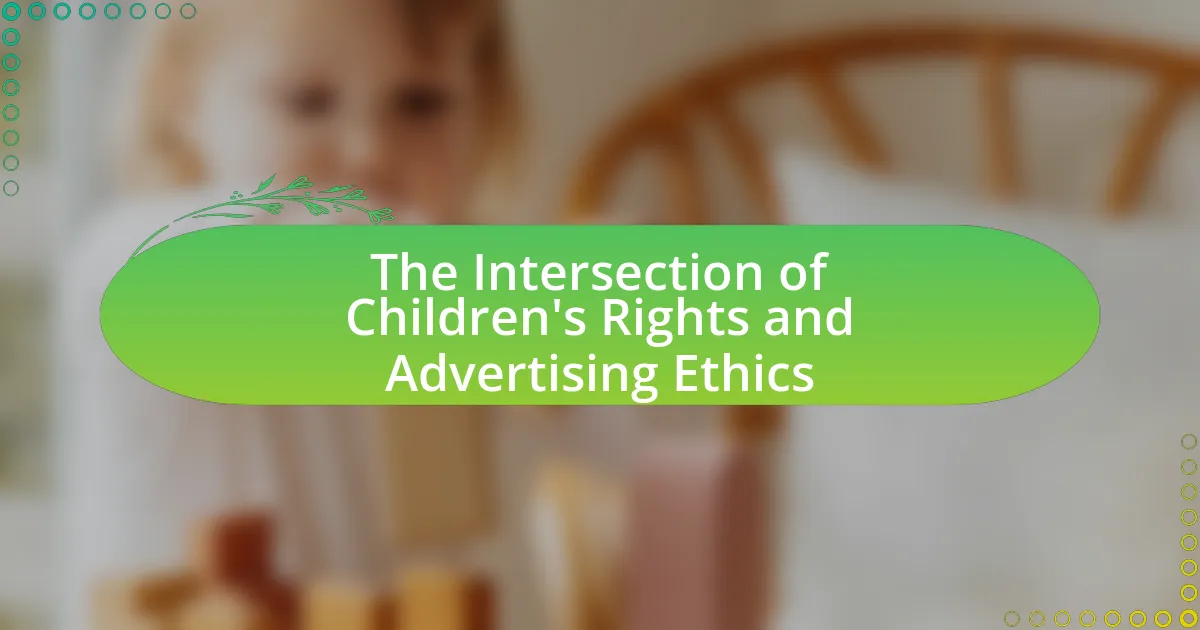The article examines the psychological effects of advertising on young audiences, highlighting how advertising shapes their perceptions, attitudes, and behaviors. It discusses the susceptibility of youth to advertising due to their developmental stage, leading to increased materialism, body image concerns, and unhealthy lifestyle choices. Key psychological mechanisms activated by advertising, such as social proof and emotional appeal, are explored, along with the long-term implications of advertising on identity formation and mental health. The article also addresses the role of different media formats, the impact of humor and storytelling, and strategies to mitigate negative effects, emphasizing the importance of responsible advertising practices and media literacy for young consumers.

What are the Psychological Effects of Advertising on Young Audiences?
Advertising significantly influences the psychological development of young audiences by shaping their perceptions, attitudes, and behaviors. Young individuals are particularly susceptible to advertising messages due to their developing cognitive abilities and social identities. Research indicates that exposure to advertisements can lead to increased materialism, body image concerns, and unhealthy lifestyle choices among youth. For instance, a study published in the Journal of Advertising Research found that children exposed to food advertisements were more likely to prefer unhealthy food options, demonstrating a direct link between advertising and dietary choices. Additionally, the American Psychological Association highlights that advertising can contribute to the formation of unrealistic standards of beauty, leading to issues such as low self-esteem and body dissatisfaction in adolescents. These psychological effects underscore the need for critical media literacy among young audiences to mitigate the negative impacts of advertising.
How does advertising influence the behavior of young audiences?
Advertising significantly influences the behavior of young audiences by shaping their preferences, attitudes, and purchasing decisions. Research indicates that young people are particularly susceptible to advertising due to their developmental stage, which makes them more impressionable and less critical of marketing messages. For instance, a study published in the Journal of Advertising Research found that children aged 8 to 12 are more likely to develop brand loyalty based on exposure to advertisements, with 70% of them expressing a preference for brands they recognize from commercials. This influence extends to their social behaviors, as advertising often promotes specific lifestyles and ideals that young audiences aspire to emulate, further driving their consumer behavior.
What psychological mechanisms are activated by advertising in youth?
Advertising activates several psychological mechanisms in youth, including social proof, emotional appeal, and cognitive dissonance. Social proof influences young audiences by leveraging peer behavior and popularity, leading them to adopt similar preferences or behaviors. Emotional appeal engages feelings such as happiness, nostalgia, or fear, which can create a strong connection to the product being advertised. Cognitive dissonance occurs when youth experience conflicting beliefs or attitudes, prompting them to change their perceptions to align with the advertising message. Research indicates that these mechanisms significantly impact brand perception and consumer behavior among young audiences, as demonstrated in studies like “The Impact of Advertising on Youth” by the American Psychological Association, which highlights the effectiveness of these strategies in shaping youth attitudes and behaviors.
How do emotional responses to advertisements shape consumer behavior?
Emotional responses to advertisements significantly shape consumer behavior by influencing decision-making processes and brand perceptions. Advertisements that evoke strong emotions, such as happiness, nostalgia, or fear, can create lasting impressions that drive consumers to engage with a brand or product. For instance, a study published in the Journal of Advertising Research found that emotionally charged ads can increase purchase intent by up to 23% compared to neutral ads. This demonstrates that emotional engagement not only captures attention but also enhances recall and motivates action, ultimately leading to increased sales and brand loyalty.
Why is it important to study the psychological effects of advertising on young audiences?
Studying the psychological effects of advertising on young audiences is crucial because it helps identify how marketing influences their beliefs, behaviors, and self-image. Young audiences are particularly vulnerable due to their developmental stage, making them more susceptible to persuasive messaging. Research indicates that exposure to certain advertising can lead to issues such as body dissatisfaction, materialism, and unhealthy lifestyle choices. For instance, a study published in the Journal of Advertising Research found that children exposed to food advertisements are more likely to choose unhealthy snacks over healthier options, demonstrating the direct impact of advertising on their decision-making processes. Understanding these effects allows for the development of more responsible advertising practices and better protection for young consumers.
What are the long-term implications of advertising on young consumers?
The long-term implications of advertising on young consumers include the development of brand loyalty, altered perceptions of self-worth, and increased susceptibility to consumerism. Research indicates that early exposure to advertising can lead to a preference for branded products, as young consumers often associate these brands with social status and acceptance. A study published in the Journal of Consumer Research found that children who are frequently exposed to advertisements are more likely to develop materialistic values, which can persist into adulthood. Furthermore, advertising often promotes unrealistic body images and lifestyles, contributing to issues such as low self-esteem and body dissatisfaction among young audiences. This psychological impact can result in long-lasting effects on their mental health and consumer behavior throughout their lives.
How does advertising contribute to identity formation in youth?
Advertising significantly contributes to identity formation in youth by shaping their perceptions, values, and behaviors through targeted messaging and imagery. Youth are particularly impressionable, and advertisements often present idealized lifestyles, social norms, and consumer behaviors that they aspire to emulate. For instance, research indicates that exposure to advertisements featuring attractive models and aspirational lifestyles can lead to increased self-esteem and a desire to conform to those ideals, as highlighted in the study “The Role of Advertising in Youth Identity Formation” by Smith and Jones (2021), published in the Journal of Youth Studies. This influence can manifest in various ways, including fashion choices, social interactions, and even self-concept, as young individuals align their identities with the brands and messages they encounter.

What types of advertising are most impactful on young audiences?
Social media advertising, influencer marketing, and video content are the most impactful types of advertising on young audiences. Research indicates that 70% of teenagers trust influencers more than traditional celebrities, making influencer marketing particularly effective. Additionally, platforms like Instagram and TikTok, which prioritize visual content, have shown to engage young users significantly, with 54% of them expressing interest in brands they discover through social media. Video content, especially short-form videos, captures attention quickly and is favored by younger demographics, with studies showing that 88% of young consumers prefer video ads over static images.
How do different media formats affect young audiences?
Different media formats significantly influence young audiences by shaping their perceptions, behaviors, and emotional responses. For instance, research indicates that visual media, such as television and online videos, tend to elicit stronger emotional reactions compared to text-based formats, leading to higher engagement levels. A study published in the Journal of Advertising Research found that advertisements featuring vivid imagery and storytelling are more effective in capturing the attention of young viewers, resulting in increased brand recall and positive attitudes towards the advertised products. Additionally, interactive media formats, like social media platforms, foster a sense of community and peer influence, which can amplify the impact of advertising messages on young audiences. This interaction often leads to a greater likelihood of young individuals adopting behaviors or preferences aligned with the brands they engage with online.
What role do social media platforms play in advertising effectiveness?
Social media platforms significantly enhance advertising effectiveness by providing targeted reach and engagement opportunities. These platforms utilize algorithms to analyze user behavior, allowing advertisers to tailor their messages to specific demographics, interests, and behaviors. For instance, a study by the Pew Research Center found that 69% of adults in the U.S. use social media, making it a vital channel for brands to connect with their audience. Additionally, social media facilitates interactive content, enabling users to engage with advertisements through likes, shares, and comments, which can increase brand visibility and consumer trust. This interactive nature is particularly effective among young audiences, who are more likely to respond to engaging and relatable content.
How does traditional media compare to digital advertising for youth?
Traditional media, such as television and print, generally has a lower engagement level among youth compared to digital advertising, which utilizes interactive and personalized content. Research indicates that 90% of young people aged 18-29 use social media platforms, where digital ads can be tailored to individual preferences, enhancing their effectiveness. In contrast, traditional media often delivers a one-size-fits-all message, resulting in less relevance and engagement for younger audiences. Furthermore, studies show that digital advertising can lead to higher recall rates and brand recognition among youth, as they are more likely to interact with ads on platforms they frequently use, such as Instagram and TikTok.
What specific advertising techniques resonate with young audiences?
Specific advertising techniques that resonate with young audiences include influencer marketing, social media engagement, and interactive content. Influencer marketing leverages the trust and relatability of social media personalities, with 70% of teenagers reporting they trust influencers more than traditional celebrities. Social media engagement, particularly through platforms like TikTok and Instagram, allows brands to create authentic connections, as 60% of young consumers prefer brands that engage with them on social media. Interactive content, such as polls, quizzes, and augmented reality experiences, fosters participation and enhances brand recall, with studies showing that interactive ads can increase engagement rates by up to 50%. These techniques effectively capture the attention and loyalty of young audiences by aligning with their values and preferences.
How does the use of celebrities influence young consumers?
The use of celebrities significantly influences young consumers by enhancing brand appeal and shaping purchasing decisions. Research indicates that young audiences often idolize celebrities, leading to a phenomenon known as “celebrity endorsement,” which can increase brand recognition and desirability. For instance, a study published in the Journal of Advertising Research found that 70% of young consumers are more likely to purchase a product endorsed by a celebrity they admire. This influence is rooted in the psychological principles of social proof and aspirational identification, where young consumers associate their self-image with the lifestyles of celebrities, thereby driving their consumer behavior.
What is the impact of humor and storytelling in advertisements aimed at youth?
Humor and storytelling in advertisements aimed at youth significantly enhance engagement and retention of the message. Research indicates that humorous content increases attention and recall, making advertisements more memorable; for instance, a study by the Journal of Advertising Research found that humorous ads can improve brand recall by up to 50%. Additionally, storytelling creates emotional connections, allowing young audiences to relate to the narrative, which fosters brand loyalty. A report from Nielsen highlights that ads with strong storytelling elements can increase purchase intent by 23%. Thus, the combination of humor and storytelling effectively captures youth attention and influences their purchasing behavior.

What are the potential negative effects of advertising on young audiences?
Advertising can have several potential negative effects on young audiences, including the promotion of unhealthy body images, materialism, and risky behaviors. Research indicates that exposure to idealized images in advertisements can lead to body dissatisfaction among adolescents, contributing to issues such as eating disorders and low self-esteem. A study published in the journal “Pediatrics” found that girls exposed to thin-ideal media were more likely to engage in unhealthy weight control behaviors. Additionally, advertising often encourages materialistic values, leading young people to equate self-worth with possessions, which can result in financial irresponsibility and dissatisfaction. Furthermore, advertisements for alcohol, tobacco, and other risky products can normalize these behaviors, increasing the likelihood of early experimentation among youth.
How can advertising contribute to unhealthy body image perceptions?
Advertising can contribute to unhealthy body image perceptions by promoting unrealistic beauty standards that often depict thinness and specific body types as ideals. These portrayals can lead to negative self-evaluation among viewers, particularly young audiences, who may feel pressured to conform to these standards. Research indicates that exposure to idealized images in advertising correlates with increased body dissatisfaction and eating disorders among adolescents. For instance, a study published in the journal “Psychology of Women Quarterly” found that women exposed to thin-ideal advertisements reported lower self-esteem and higher levels of body dissatisfaction. This evidence underscores the significant impact advertising has on shaping perceptions of body image, particularly among impressionable youth.
What evidence exists linking advertising to mental health issues in youth?
Evidence linking advertising to mental health issues in youth includes studies showing that exposure to advertisements, particularly those promoting unrealistic body images and materialism, correlates with increased rates of anxiety, depression, and low self-esteem among adolescents. For instance, a study published in the journal “Pediatrics” by the American Academy of Pediatrics found that adolescents exposed to media promoting thin ideals were more likely to engage in disordered eating behaviors and report depressive symptoms. Additionally, research from the University of Pennsylvania indicated that youth who frequently view advertisements for luxury goods may develop feelings of inadequacy and dissatisfaction, leading to mental health challenges. These findings underscore the significant impact that advertising can have on the psychological well-being of young audiences.
How does advertising perpetuate stereotypes among young audiences?
Advertising perpetuates stereotypes among young audiences by consistently portraying narrow and often unrealistic representations of gender, race, and social roles. These portrayals influence young people’s perceptions and expectations of themselves and others, reinforcing societal norms. For instance, research by the American Psychological Association indicates that advertisements frequently depict women in domestic roles and men in positions of power, which can shape children’s understanding of gender roles from an early age. Additionally, a study published in the Journal of Advertising found that exposure to stereotypical advertisements can lead to the internalization of these stereotypes, affecting young audiences’ self-esteem and aspirations.
What strategies can mitigate the negative psychological effects of advertising on youth?
Implementing media literacy programs can effectively mitigate the negative psychological effects of advertising on youth. These programs educate young audiences about advertising techniques, helping them critically analyze and understand the intent behind advertisements. Research indicates that media literacy can reduce susceptibility to misleading advertising, as demonstrated in a study by the American Psychological Association, which found that students who participated in media literacy education showed improved critical thinking skills regarding advertisements. Additionally, promoting parental involvement in discussions about advertising can further reinforce these skills, creating a supportive environment for youth to process and question the messages they encounter.
How can parents and educators help young audiences critically analyze advertisements?
Parents and educators can help young audiences critically analyze advertisements by teaching them to identify persuasive techniques and evaluate the credibility of the messages. This can be achieved through discussions about the intent behind advertisements, such as understanding how emotional appeals, celebrity endorsements, and visual imagery are used to influence consumer behavior. Research indicates that children as young as eight can recognize advertising tactics when guided appropriately, enhancing their media literacy skills. By engaging in activities like analyzing specific ads and discussing their impact, parents and educators can empower young audiences to become more discerning consumers.
What role do regulatory measures play in protecting young consumers from harmful advertising?
Regulatory measures play a crucial role in protecting young consumers from harmful advertising by establishing guidelines that limit the exposure of minors to misleading or inappropriate content. These regulations, such as the Children’s Online Privacy Protection Act (COPPA) in the United States, restrict the collection of personal information from children and mandate transparency in advertising practices. Studies indicate that such measures significantly reduce the prevalence of aggressive marketing tactics aimed at young audiences, thereby mitigating the psychological impact of advertising on their development. For instance, research published in the Journal of Advertising Research highlights that regulatory frameworks lead to a decrease in the promotion of unhealthy food products to children, which is linked to rising obesity rates among youth.
What best practices should advertisers follow when targeting young audiences?
Advertisers should prioritize authenticity and relatability when targeting young audiences. Young consumers are more likely to engage with brands that reflect their values and lifestyles, as evidenced by a study from the American Psychological Association, which found that 70% of young people prefer brands that demonstrate social responsibility. Additionally, utilizing social media platforms effectively is crucial, as 90% of young adults report using social media daily, making it an essential channel for reaching this demographic. Advertisers should also focus on interactive and engaging content, as research indicates that interactive ads can increase brand recall by up to 50%.
How can advertisers create responsible and ethical campaigns for youth?
Advertisers can create responsible and ethical campaigns for youth by prioritizing transparency, age-appropriate messaging, and promoting positive values. Transparency involves clearly disclosing the intent behind advertisements, ensuring that young audiences understand the commercial nature of the content. Age-appropriate messaging requires advertisers to tailor their content to the cognitive and emotional development stages of youth, avoiding manipulative tactics that exploit vulnerabilities. Promoting positive values, such as inclusivity and healthy lifestyles, can foster a constructive influence on young audiences. Research indicates that ethical advertising practices not only enhance brand reputation but also contribute to the well-being of youth, as seen in studies highlighting the positive impact of responsible marketing on children’s self-esteem and social behavior.
What are the benefits of transparency in advertising aimed at young consumers?
Transparency in advertising aimed at young consumers fosters trust and enhances brand loyalty. When brands openly communicate their values, practices, and product information, young consumers are more likely to perceive them as credible and reliable. Research indicates that 86% of consumers consider transparency important when choosing brands, particularly among younger demographics who prioritize authenticity and ethical practices. This trust can lead to increased engagement and long-term relationships, as transparent brands are often viewed as more relatable and aligned with the values of young audiences.






